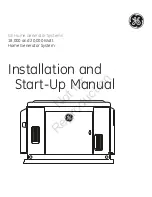
325
Measurement of main circuit voltages, currents and powers
Measuring Points and Instruments
Item
Measuring Point
Measuring Instrument
Remarks (Reference Measured Value)
Power supply voltage
V1
R/L1 and S/L2
S/L2 and T/L3
T/L3 and R/L1
Moving-iron type AC
voltmeter
Commercial power supply
Within permissible AC voltage fluctuation
Power supply side
current
I1
R/L1, S/L2, T/L3 line
current
Moving-iron type AC
ammeter
Power supply side
power
P1
R/L1, S/L2, T/L3 and
R/L1 and S/L2,
S/L2 and T/L3,
T/L3 and R/L1
Digital power meter
(designed for inverter) or
electrodynamic type single-
phase wattmeter
P1=W11+W12+W13 (3-wattmeter method)
Power supply side
power factor
Pf1
Calculate after measuring power supply voltage, power
supply side current and power supply side power.
Output side voltage
V2
Across U and V, V and W,
and W and U
Rectifier type AC voltage
meter
(moving-iron type cannot
measure)
Difference between the phases is within 1% of the
maximum output voltage.
Output side current
I2
U, V and W line currents
Moving-iron type AC
ammeter
Difference between the phases is 10% or lower of
the rated inverter current.
Output side power
P2
U, V, W and
U and V, V and W
Digital power meter
(designed for inverter) or
electrodynamic type single-
phase wattmeter
P2 = W21 + W22
2-wattmeter method (or 3-wattmeter method)
Output side power
factor
Pf2
Calculate in similar manner to power supply side power factor.
Converter output
Across P/+ and N/-
Moving-coil type
(such as tester)
Inverter LED display is lit. 1.35 × V1
Frequency setting
signal
Across 2(+) and 5
Moving-coil type
(tester and such may be
used)
(internal resistance 50k
or
more)
0 to 10VDC, 4 to 20mADC
"5" is
common
Across 4(+) and 5
Frequency setting
power supply
Across 10(+) and 5
5.2VDC
Frequency meter
signal
Across FM(+) and SD
Approximately 5VDC at maximum
frequency
(without frequency meter)
Pulse width T1 : Adjust with
C0 (Pr.
900)
Pulse cycle T2 : Set with
Pr. 55
(frequency monitor only)
"SD" is
common.
Start signal
Select signal
Across SD and STF, STR,
RH, RM, or AU(+)
When open
20 to 30VDC
ON voltage: 1V or less
Fault signal
Across A and C
Across B and C
Moving-coil type
(such as tester)
Continuity check
Normal
Fault
Across A and C
Discontinuity
Continuity
Across B and C
Continuity
Discontinuity
Use an FFT to measure the output voltage accurately. An FA tester or general measuring instrument cannot measure accurately.
When the carrier frequency exceeds 5kHz, do not use this instrument since using it may increase eddy-current losses produced in metal parts inside the
instrument, leading to burnout. In this case, use an approximate-effective value type.
When the setting of
Pr. 192 A,B,C terminal function selection
is positive logic
A digital power meter (designed for inverter) can also be used to measure.
Pf
1
P
1
3V
1
I
1
------------------------ 100
=
%
Pf
2
P
2
3V
2
I
2
------------------------ 100
=
%
8VDC
T1
T2
Содержание FR-F700PJ Series
Страница 13: ...IX MEMO ...
Страница 29: ...16 MEMO ...
Страница 76: ...63 MEMO ...
Страница 299: ...294 MEMO ...
Страница 321: ...316 MEMO ...
Страница 346: ...341 APPENDIX This chapter provides the APPENDIX of this product Always read the instructions before using the equipment ...
















































